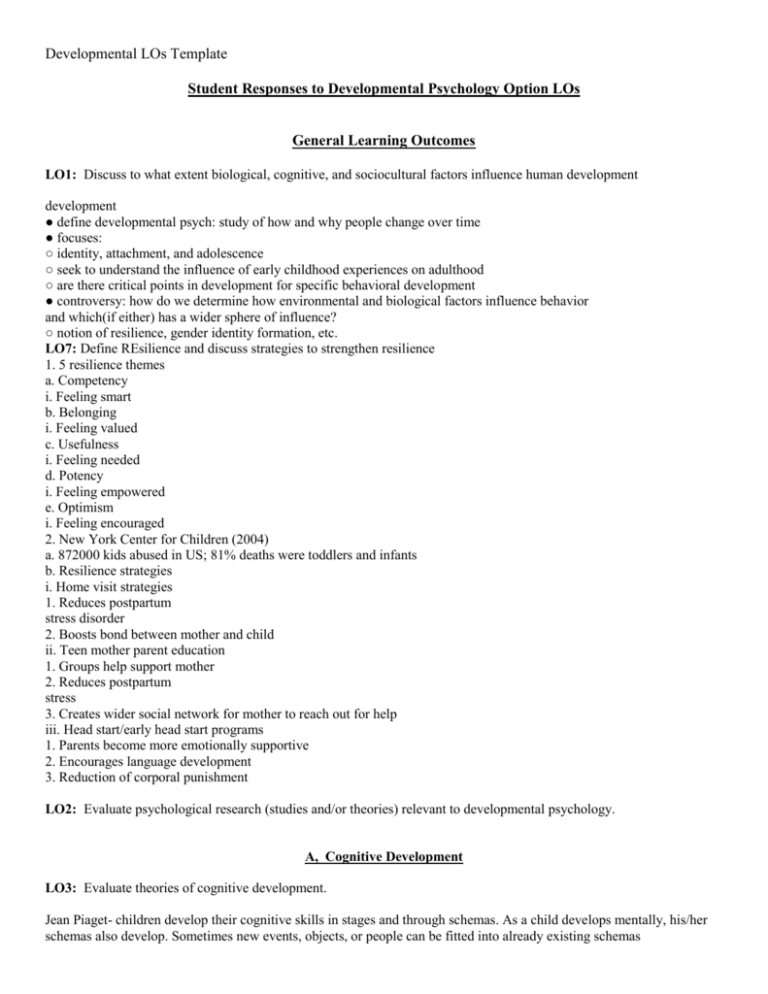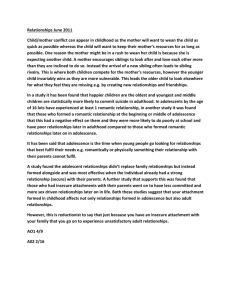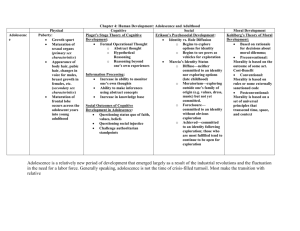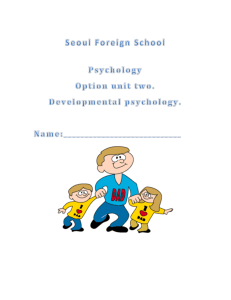Developmental LOs Template Student Responses to Developmental
advertisement

Developmental LOs Template Student Responses to Developmental Psychology Option LOs General Learning Outcomes LO1: Discuss to what extent biological, cognitive, and sociocultural factors influence human development development ● define developmental psych: study of how and why people change over time ● focuses: ○ identity, attachment, and adolescence ○ seek to understand the influence of early childhood experiences on adulthood ○ are there critical points in development for specific behavioral development ● controversy: how do we determine how environmental and biological factors influence behavior and which(if either) has a wider sphere of influence? ○ notion of resilience, gender identity formation, etc. LO7: Define REsilience and discuss strategies to strengthen resilience 1. 5 resilience themes a. Competency i. Feeling smart b. Belonging i. Feeling valued c. Usefulness i. Feeling needed d. Potency i. Feeling empowered e. Optimism i. Feeling encouraged 2. New York Center for Children (2004) a. 872000 kids abused in US; 81% deaths were toddlers and infants b. Resilience strategies i. Home visit strategies 1. Reduces postpartum stress disorder 2. Boosts bond between mother and child ii. Teen mother parent education 1. Groups help support mother 2. Reduces postpartum stress 3. Creates wider social network for mother to reach out for help iii. Head start/early head start programs 1. Parents become more emotionally supportive 2. Encourages language development 3. Reduction of corporal punishment LO2: Evaluate psychological research (studies and/or theories) relevant to developmental psychology. A, Cognitive Development LO3: Evaluate theories of cognitive development. Jean Piaget- children develop their cognitive skills in stages and through schemas. As a child develops mentally, his/her schemas also develop. Sometimes new events, objects, or people can be fitted into already existing schemas (assimilation), but other times schemas are needed to be modified or created in order to accommodate new events the child encounters. Four stages of cognitive development due to maturation and the environment: Sensory motor (0-2 years old) - Children have no formal schemas and only know the world through their senses and motors. Egocentricism is found in this stage as the children all think of themselves as the center of the world. They also believe that if they cannot see an object, that means the object no longer exist. Pre-operational stage (2-7 years old)- children cannot depend on internal mental rules, focus only on one object or one aspect at a time (centration), and classifies objects into the same group based on shape or color (classification limitation). They also begin to have imaginary friends. Concrete operational stage (7-11 years old)- they start to develop rules or schemas about real objects in real world and learn the idea that object tend to stay the same even if its shape changes. Formal operational stage (11 and older)- they can think abstractly and manipulate ideas and solve problems without the need of physical objects. Evaluation: Piaget’s theory contributes significantly to our understanding of mental development. Over the years, Piaget also modifies his theory in response to criticism and is the first to investigate whether maturation is based on biological factors. However, in his studies, his sample size is rather small, making it hard to generalize to the wider population and other culture, and his methods are deemed too formal for children. Piaget is also criticized for failing to distinguish between competence and performance in his research and for underestimating the role of language and social development in his theory. Vygotsky- focused more on social environment and language. Children can gain knowledge through their culture and through the interaction they have with other people. Observation of their own culture can teach them the social norms in their society. Children also acquire knowledge through imitation, instructions, and collaborative learning. Language develops in 3 stages: Pre-intellectual or social speech (0 – 3 years old) children’s thoughts are not constructed with language and they use speech to make certain changes. Egocentric speech (3 – 7 years old)- language controls behavior when it is spoken out loud. Inner speech( 7 or older)- they use language silently to think and publicly to communicate out loud. Zone of proximal development- refers to the difference between what children can do on their own and what they can do with outside help, and scaffolding is the idea that children would accomplish more if they have assistance from others than if they were to do it by themselves. Evaluation: Vygotsky’s theory of cognitive development in children is criticized for being rather vague about social influence and for being too focused on social interaction. It nonetheless is a useful concept in teaching and in predicting a child’s ability in class. LO4: Discuss how social and environmental variables may affect cognitive development social and environmental factors affect cognitive development (nature v. nurture) environmental variable- child’s nutrition social variable- parenting style environmentalaffects a child pre-birth (the mother’s diet during gestation ) Hibbeln et al (2007)- compared children whose mothers consumed omega-3 fatty acids during pregnancy and those who did not babies w/o = poor motor skills (lack of spatial cognitive development) as a person develops the food they eat breaks apart and then rebuilds as DNA DNA controls gene expression which controls the development of proteins protein development is how one forms blood cells, muscle cells (and as this study indicates neurons) malnourishment puts children at a disadvantage before they are even born this could also be considered a social factor based on the knowledgeability of the mother social- Michigan Department of Education (2001)- believed parent’s expectations and involvement had the greatest impact of academic success children motivated by parents had higher self-esteem more involved & confident= higher grades & test scores, higher rate of attendance & graduation decrease of violence, drug abuse, and suspension MDE declared the key parenting style was: having a daily routine, incorporating moral values, and monitoring or providing activities outside of school LO5: Examine attachment in childhood and its role in the subsequent formation of relationships o o o What must first be understood... attachment = strong emotional connection between one person and another, such as the bonds commonly seen between a child and its primary caregiver Child Attachment Behavior Theory John Bowlby (1951) believed the close relationship between child and mother is a basic biological need for survival behaviors such as smiling and crying are genetically based social signals that encourage parents to care and interact with their children o there is a desire to be near the person a child is most attached to in the face of distress for comfort and safety helps to build attachment schemas .... can have affect on later relationships Mary Ainsworth (1978) “The Strange Situation” supplied Bowlby’s theory with empirical data o study looked at the interaction when a mother leaves and arrives had a mother and stranger interact... come and go while in the same room as child playing... each occasionally interacts with child defined three types of attachment behavior o avoidant/detached (20%) mothers insensitive, children indifferent and had little fear of strangers o secure (70%) active mothers, children very upset when mother left o ambivalent/anxious resistant (10%) inconsistent interaction on mothers part, children not easily soothed by mother Main and Solomon (1990) suggested another type of attachment behavior o insecure/disorganized/disoriented depressed mothers, removed children Role of Early Attachment in Future Relationships Hazan and Shaver (1987) argued that those in secure relationships had loving parents as a children Siegel and Jaffre (2007) proved that nonverbal skills used as a baby (refer back to Bowlby’s theory) as a means of communication with parents are important in later relationships o recognizing nonverbal signs of distress, etc. Mlyake (1985) took into account the issue of culture and its role of attachment in future relationships (refer back to the Ainsworth study) o Japanese mothers rarely separated from children... show greater amount of secure attachment o U.S. children encouraged to be more independent... show greater amount of avoidance attachment LO6: Discuss potential effects of deprivation or trauma in childhood on later development LO7: Define resilience and discuss strategies to build resilience A. Define Resilience the process of avoiding adverse outcomes when facing hardships Why needed?/purpose? o Helps a person bounce back after a stressful situation Make an argument Numerous sources of resilience. o academic competence, o an effective and supportive family life, o a warm relationship between mom and dad, o an effective social life, the environment, and also employment. Sources of adversity o Poverty and results in disadvantages, social exclusion, and unemployment/ low quality work. B. Support argument with studies Schoon & Bartley (2008) o Longitudinal study which looked at other studies. o The results were based on studies of over 400, 000 people. o They found that poverty results in disadvantages. Social exclusion, which is being excluded from "normal" social programs. Unemployment, or low quality work. can lower a person's self esteem, thus affecting families a d weakening their ties Sagor (1990) o Concluded that schools can provide support for children. o Themes Competency, usefulness, potency, and optimism. Competency is feeling successful, belonging equals feeling wanted, an individual feels needed w/ usefulness, potency is feeling unpowered, and optimism is feeling hopeful. Ackerman (1997) o Focused on helping children who had been affected by the divorces of their parents The New York City Center for Children (2004) o research shows that 81% of deaths from child abuse are infants and toddlers o Over 200,000 children are abused o Strategy to strengthen resilience Home visit programs. These programs decrease child abuse in low income families, and remind moms of their obligations to care for their children Brother & Repucci (1897) o Suggests the strategy if teen mom-parent education. These groups are created to provide peer support and extended family in child's care Love et. al. (2005) o introduced the strategy of early headstart programs These programs are created to help parents become more emotionally supportive and to decrease corporal punishment Mahoney et. al. (2005) o Introduced after-school programs. These programs allow students to achieve better test scores and receive better motivation. Elder and Conger (2000) o looked at rural families in Iowa o They IDE tidied five resources of resilience. 1. Strong international bonds. 2. to be socialized in productive roles in social leadership 3. To maintain a network of positive engagement. 4. have close relationships with grandparents 5. Gave interactions in the community. 1. 5 resilience themes a. Competency i. Feeling smart b. Belonging i. Feeling valued c. Usefulness i. Feeling needed d. Potency i. Feeling empowered e. Optimism i. Feeling encouraged 2. New York Center for Children (2004) a. 872000 kids abused in US; 81% deaths were toddlers and infants b. Resilience strategies i. Home visit strategies 1. Reduces post-partum stress disorder 2. Boosts bond between mother and child ii. Teen mother parent education 1. Groups help support mother 2. Reduces post-partum stress 3. Creates wider social network for mother to reach out for help iii. Head start/early head start programs 1. Parents become more emotionally supportive 2. Encourages language development 3. Reduction of corporal punishment iv. Afterschool programs 1. One year of participation shown higher test and reading scores 2. Better motivation 3. Schoon and Bartley a. Meta-analysis; 40000 people b. 3 sources of adversity i. Poverty and its result in disadvantages 1. Leads to less opportunities and mental and physical health issues ii. Social exclusions 1. Poor families have facilities in disrepair iii. Unemployment/low quality work 1. Leads to low self-esteem 2. Kids may feel out of control of their lives 3. Can strain family relationships c. 4 sources of resilience i. Academic competence 1. Life outside of classroom motivated with positive outlooks for the future ii. Effective/supportive family life 1. Parents’ showed interest in kid’s education 2. Read to kids, family activities, supportive father figure good parent relationship iii. Employment 1. Creates family cohesion iv. Effective social environment LO8: Discuss the formation and development of gender roles Deprivation o o Deprivation is living in a state of neglect, lacking basic physical, emotional and social needs. Living in a state of neglect, and lacking basic physical, emotional, or social needs is due to parental problems and living in poverty. Deprivation can affect children through cognitive impairment and attachment issues o Trauma o Arises from a shocking event such as a death of a loved one, abuse, and natural disasters o Usually has long lasting effects on person Resilience o The ability to recover or bounce back from even very stressful events Rutter et al. (2001) o A longitudinal study of 324 Romanian adoptees, raised since infancy in institutions before adoption. o Found three significant differences: Adoptees had attachment problems Difference in measures of over activity and cognitive impairment Romanian children showed near autistic features o More problems from children who left Romania when they were older o Argued that the chance of normal social functioning is substantially better if the child leaves the institution early. (pg 201) o Koluvhova (1971, 1991) Clarke and Clare (1998): that deprived children can recover from even very adverse conditions if they are removed from such situations and given proper care and attention Koluvhova child abuse study (1971, 1991) Longitudinal study on Czech twin boys Case study indicates that if a child is moved for an extremely impoverished environment it is possible to revise the effects of deprivation. (pg. 202) LO9: Explain cultural variations in gender roles -GENDER IDENTITY -person's idea of what sex they are as well as others -GENDER ROLES -activities prescribed to each gender --males expected to play rough and play with trucks and guns }western cultures --females = nurturing, playing with dolls } western cultures -MATSUMOTO '94 -relatively excepted def of CULTURE --a set of attitudes, values, beliefs, and behaviors shared by a group of people and passed from one generation to the next by cultural practices and language -MEAD '35 -Margaret Mead --experiment that personifies idea of cultural variations and gender roles --observed 3 tribes: ---Mundugumour: both men and women behave "traditionally" ---Arapesh: "traditional" ---Tchambuli: inverted gender roles -WILLIAMS and BEST '90 -gender stereotypes arise out of gender roles -when stereotypes become real they serve as a model for gender roles in society --teaches what may be "socially appropriate" --start in children at young age BEST et al '77 -cross cultural study on gender stereotypes on kids from UK, Ireland, & US -ages 5-8 -boys and girls said girls are soft hearted and males are strong --age 8 more complex stereotypes, but along same lines -EAGLY '87 -social role theory -gender stereotypes come from different roles men and women usually occupy -roles often consistent with societal perceptions of men and women. -GOFFMAN '77 -gender roles will shift when society shifts REINICKE '06 -being a father is important in most cultures -many fathers prefer to be with their child -mothers are stereotypically in the presence of child at all times ENGLE -fathers who participate in fathering programs more likely to participate in child's life LO10: Describe adolescence - - - Adolescence o Transitional period generally between childhood and adulthood o Almost uniquely a western phenomenon Term “adolescence” is not universal o Period of development surrounding puberty o Cultural variations Adolescents hit this stage at different point during lifetime according to cultural norms o Hall (1904) Adolescence is a period of “storm and stress” Viewpoints based of LoAs o Cognitive 1st formal operational thought developes (Piaget) Abstract thought o Sociocultural Politically/socially constructed paradigm Set years ~10-20 yr. (World Health Organization) o Biological Rapid increase in growth Redistribution of tissue and body fat Reproduction became a possibility Pituitary gland releases hormones Schlegel & Berry (1991) o Even if there is no word for adolescence, all cultures have some notion of what it is Initiation ceremonies LO11: Discuss the relationship between physical change and development of identity during adolescence LO12: Examine psychological research into adolescence - Erikson Erikson' approach that was presented in the 1950s was that adolescence is a period of stress and uncertainty brought about by intense physical change which causes a crisis in identity. -argued that the crisis stage in life was normal and an essential part of identity formation -parts of theory • Intimacy • Time • Industry • Negative identity -introduces psychosocial moratorium. - the temporary suspension of activity during the period of identity formation Evaluation of Erikson • his point that adolescence is associated with low self-esteem and low productivity when this is not always the case: -more likely to be associated with positive identity formation (Offer et al. 1981) • he did not have any empirical research to support his view. -Marcia Marcia's approach was a reform of Erikson's identity research and created identity statuses of identity • Identity diffusion – Have no options and are not looking for any • Identity foreclosure – Settled on an identity that is chosen by others • Identity moratorium – Going through a crisis and exploring multiple options and has not made a choice. • Identity achievement – Chosen a path after having an identity crisis Evaluation of Marcia • was an extension of Erikson’s work and was an attempt to make it more empirically and useful. • suggest confusion and crisis decline as adolescence progresses, not always true • Waterman and Waterman (1975) suggested The theory suffers from cohort effects – lack difference in groups. Define adolescence o The period of development between puberty and adulthood Research: o Erickson—theory of psychosocial development (1968) Defined adolescence as a period of identity crisis—identity vs. role confusion This stage is marked by physical growth & hormonal changes Self-concept changes as a result of developmental crisis Moratorium—period of time an individual questions their sexuality, future, and identity If identity crisis is resolved then the adolescent is more confident about their identity Role confusion is the uncertainty of who one is and ones purpose—which may result in negative or unacceptable identity Erickson claims that adolescents must establish an adult personality and develop commitment to work and a role in life (to prepare for the next stage—intimacy vs. isolation) The stage of committing to oneself or another person A risk of this stage is that some fear commitment because of the fear of losing their own identity Evaluation of theory: o Based on assumption that development is universal, sequential, & characterized by developmental task o The stages described are not applicable to other cultures o Theory is descriptive not explanatory o However, it is the only theory dealing with lifelong development o Espin et al. (1990) Tested Erickson’s theory of adolescent developmental crisis Longitudinal case study Content analysis of 71 letters over 9 years from a Latin American female Found that themes of identity were prominent in the predicted period of Erickson Themes of intimacy increased through the next period Limitations: cannot be generalized Strengths: supports Erickson’s theory








